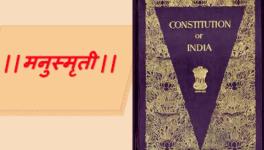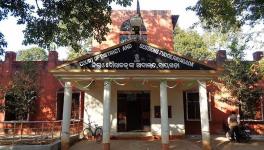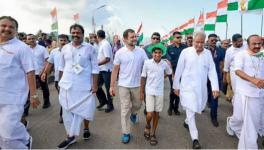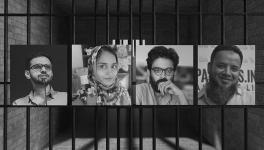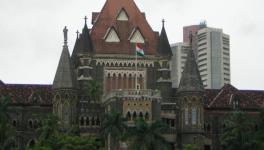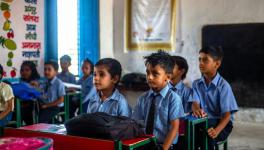R-Day Parade: March-Pasts and Rattle of Tanks Don’t Bolster Democracy
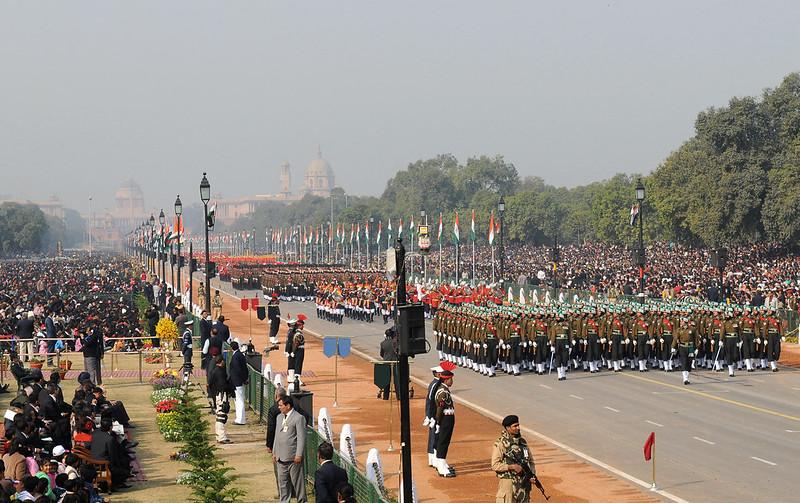
The slug-fest between the Centre and States over the tableau displays during the Republic Day Parade is back again in full fury. Following the parade’s theme this year—India@75—Tamil Nadu, West Bengal and Kerala submitted their respective tableaux to the Ministry of Defence (MoD), the controlling authority for the parade held on 26 January every year.
The Tamil Nadu tableau proposed sketches that depict the contribution of renowned freedom fighters from the state, including VO Chidambaram, Subramania Bharathi, popularly known as Mahakavi Bharathiyar, Rani Velu Nachiyar and other women soldiers. The West Bengal tableau sought to feature Netaji Subhas Chandra Bose and his Indian National Army, whose 125th birth anniversary falls on 23 January. The tableau would have carried portraits of Ishwar Chandra Vidyasagar, Rabindranath Tagore, Swami Vivekananda, Chittaranjan Das, Sri Aurobindo, Matangini Hazra, Birsa Munda and Nazrul Islam. Kerala’s tableau was of the social reformer Sree Narayana Guru and the Jatayu Park monument, the world’s biggest bird sculpture in a national park covering 65 acres over four hills near Kollam.
The tableaux from all three states were rejected, and the Chief Ministers responded sharply. Tamil Nadu Chief Minister MK Stalin said it was a “matter of grave concern” to the state and its people and sought the Prime Minister’s “urgent intervention” to include the tableau. West Bengal Chief Minister Mamata Banerjee reacted bluntly, saying, “Bengal was at the forefront of the Indian freedom struggle and paid the heaviest price for the country’s Independence through the partition. The people of West Bengal are deeply pained by this attitude of the central government.” Kerala Chief Minister Pinarayi Vijayan sought the Prime Minister’s intervention too, saying, “We have no idea why the Centre is against the social reformer [Narayana Guru]. The float was avoided at the eleventh hour, and the government owes an explanation to the state.”
The central government’s response was parrot-like, a repetition of what it said in 2020 when tableaux of the Opposition-ruled states West Bengal, Maharashtra and Kerala were rejected for one reason or another. It claimed that in the process laid down to select tableaux for the Republic Day parades, every year, the MoD invites proposals from all States and Union Territories and central ministries or departments, with a list of suggested themes. The themes can include crucial episodes from the history of the State or Union Territory, their festivals or cultural and architectural heritage, their significant social and economic schemes, the environment, and so on. An expert committee then evaluates the proposals based on their theme, concept, design and visual impact, and recommends some of them. The final decision is based on these recommendations. But the Centre provided no specific reason for why the tableaux of the three states got rejected.
The Centre may have described the process of selecting State tableaux, but this is not the first time questions are being raised about how to celebrate Republic Day in India. Should the pageant take precedence, or should it be the parades that get primacy is the fundamental issue. Consider first the definition of both. While a pageant is an elaborate, colourful exhibition or spectacle, often accompanying music and a series of tableaux, a parade is the ceremonial formation of a body of troops before a superior officer. Further, a Republic is a government in which the supreme power rests with the citizens, which they exercise through the representatives they elect. Therefore, there is nothing military about a Republic. It follows that Republic Day celebrations should be citizen-centric, with plenty of song, dance and tableaux forming a pageant.
Instead, what dominates India’s Republic Day celebration is a military and paramilitary parade that relegates the pageant to the background. It is the MoD, not the ministries of home or culture, that conceives, plans and manages this mega-show. This militarisation is how the focus of the celebration is kept on the parade, not the pageant. The typical media headlines on the 74th Republic Day celebration ran like this: “Republic Day 2021: India’s Heritage, Diversity, Military Might on Display at Rajpath”, or “Republic Day Parade 2021 Highlights: India’s Military Might, Cultural Diversity on Display at Rajpath”.
We find only cursory references to the cultural pageant represented by tableaux, while the media concentrates on the “military might” on display. Consider the descriptions of the parade “Capt. Karanveer Singh Bhangu leads the 54 Armoured Regiment atop T-90 Bhishma. The made-in-India tank is produced at Engine Factory Avadi.” Or we hear, “Capt. Quamrul Zaman is leading the Brahmos Missile and its Mobile Autonomous Launcher. The surface-to-surface supersonic cruise missile BrahMos was developed as part of an India-Russia joint venture. The Brahmos are deployed along the Line of Actual Control in strategic locations such as Ladakh and Arunachal Pradesh.” Further, “Capt. Vibhor Gulati leads 841 Rocket Regiment’s Pinaka Multi Launcher Rocket System. The 214 mm Pinaka MBRL is one of the most advanced rocket systems in the world. A fully automated system, it can deliver firepower within a short span of time over large area.”
The air-power on show is described in such words: “Rudra formation, comprising a Dakota aircraft flanked by 2 Mi-17 IV helicopters, Rafale with 2 Jaguar deep penetration strike aircraft and 2 MiG-29.” “One Rafale with 2 Jaguar deep penetration strike aircraft and 2 MiG-29 Air Superiority Fighters in Eklavya formation are the next to fly past, at 300m height and a speed of 780 km/h.” “The Republic Day parade culminates with a single Rafale aircraft flying at a speed of 900km/hr carrying out a vertical Charlie.”
The supremacy of the military displays during the Republic Day celebrations is also evident. A Lieutenant-General commands the parade with a Major General as the second-in-command. The marching contingent of the Army includes infantry regiments, an armoured regiment, the Artillery and Territorial Army regiments. Delegations of the Navy and Air Force comprise 144 young sailors or airmen. The paramilitary and auxiliary civil forces include the Border Security Force and Camel Contingents, the Indian Coast Guard, the Sashastra Seema Bal, the Indo Tibetan Border Police, Delhi Police and the National Cadet Corps.
As of now, the Republic Day parade is mainly meant to demonstrate the might of the Indian state and its armament technologies and the weapons of defence or offence that it commands. The question is, for whom are these “demonstrations” meant. Is it for our so-called enemies to beware, or else? Or is it directed at our own citizens, so that they obey the state unquestioningly, or else? If it is the former, the display is meaningless since our “enemies” know what military-wares we possess, most of which are imported. If it is the latter, it is against the very principles of democracy in which a citizen is sovereign.
The philosopher Jean-Jacques Rousseau famously said, “Obedience is not the duty of a citizen.” On the other hand, if the idea of a militarised Republic Day parade is to provide a sense of security to the people, by parading troops at Rajpath and displaying military hardware, it is a sheer waste of time and money.
The ritual militarisation of the Republic Day parade is an attempt to reinforce a form of obsessive nationalism, which seek to condition people’s minds and limit their horizon by spreading a nationalist euphoria against the spirit of democracy. We are asked to see the march of the Army—the disciplined, tight, masculine bodies of trained, even robotic, soldiers saluting the flag. And we are supposed to feel good, cherish the narcissism of the nation and believe we are more powerful than our “enemies”. The sound of the boots of the marching forces and the rattle of their tanks and guns cannot create a united and healthy nation. A fractured or fragmented nation can heal only by eradicating the evils of bigotry, arbitrariness, injustice, hate and intolerance within it, and reinforcing democratic values. The present ruling dispensation is doing just the opposite.
As we approach the day of festive celebration, we see a violent nation with heightened social tensions and horrendous economic inequality, and multiple aggressions in the name of exclusionary identities. Sanity demands we leave the rhetoric of nationalism and the valorisation of militaristic heroism to converse with icons such as Mahatma Gandhi, Rabindranath Tagore, Bhimrao Ambedkar and Jayaprakash Narayan. They are the ones to draw inspiration from today, so we can create an India with equity, compassion, civility and kindness.
For this to happen, Republic Day should be less militarised and more civilised, in the sense that it should become a people’s pageant and celebrate its citizens. Then there will not be complaints of the rejection of tableaux, as every State and Union Territory will not only have more displays but also give the Republic Day celebrations a much higher cultural profile.
Long ago, Greek philosopher-statesman Aristotle spoke the prophetic words, “Republics decline into democracies and democracies degenerate into despotism.” This prophecy is coming true for India, though it is touted as the “largest democracy”. The remedy is to reduce militarisation by making Republic Day a celebration of citizens. That could strengthen our democracy.
The writer is a former Indian Army and IAS officer. The views are personal.
Get the latest reports & analysis with people's perspective on Protests, movements & deep analytical videos, discussions of the current affairs in your Telegram app. Subscribe to NewsClick's Telegram channel & get Real-Time updates on stories, as they get published on our website.









